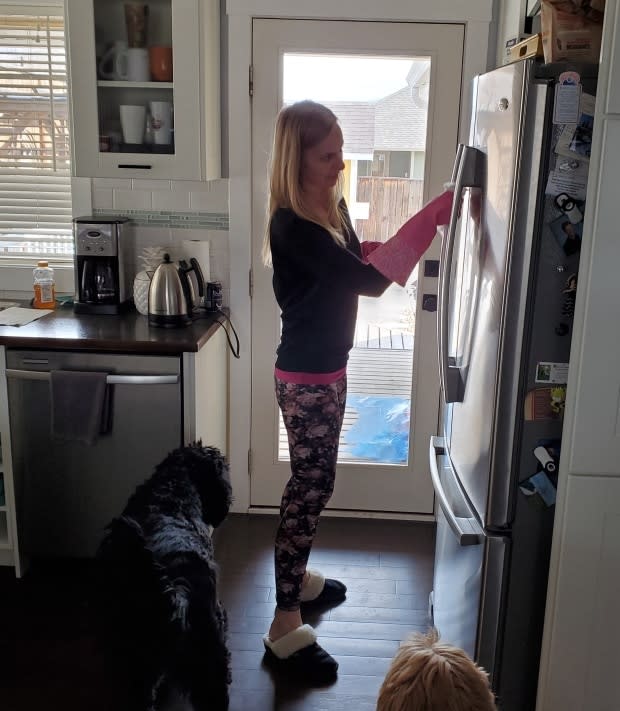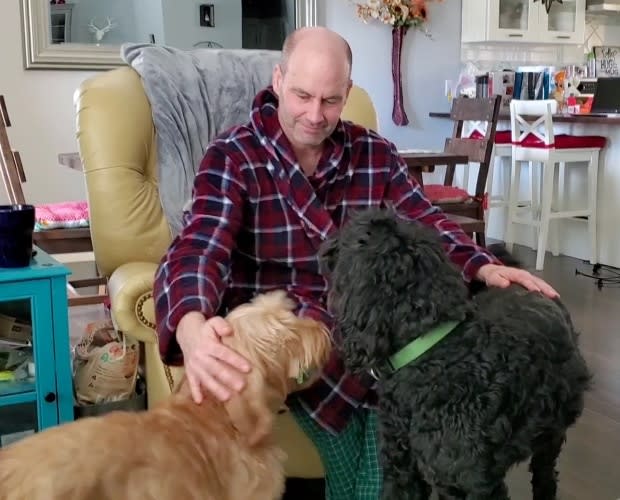Both parents have COVID-19. The challenge now is to keep their boys healthy
For Dana Elliott, her COVID-19 challenge has been threefold: first, she was caring for her husband who got sick with it. Then, she's had to fight it herself — all the while trying to prevent her two teenage sons from getting ill too.
That's meant a lot of leaving her two boys alone to fend for themselves, and a lot of cleaning.
"The kids are locked in their rooms, playing Xbox," said Elliott, 46, of Kamloops, B.C.
"I text with them, or talk to them from the hallway."

Her family's experience is something many households may go through battling COVID-19, and health officials have created a guide to prepare for: how to look after a loved one at home who has the highly-infectious virus, while keeping it at bay from everyone else in the family.
"Its been taxing. I've felt stretched pretty thin," said Elliott.
Both Elliott and her husband, Keith Elliott, have tested positive for COVID-19. So far, their two teenage sons, ages 15 and 13, have no symptoms. One briefly had sore throat, was tested and came up negative. The other hasn't been tested, said his mom, as he didn't meet the criteria.
Husband in ICU
The familly of four is in isolation and not sure how long it will last.
Keith Elliott, 48, started showing some symptoms March 12. Twelve days later, he landed in the Intensive Care Unit at Royal Inland Hospital in Kamloops. He was on oxygen, but did not have to go on a ventilator.
"Pretty scary stuff," said Keith Elliott.
He works as a carpenter for the Merritt School District, and notified the district as soon has he had a positive test, on March 20. He's now on the mend, and was discharged home March 28.

Meanwhile, Dana Elliott, who works as a pharmacy technician at the hospital, started to notice she was feeling unwell March 23. Her symptoms were milder than Keith's — a headache, tightness in the chest, pink eye, shortness of breath, and some burning in the lungs.
Overall "being tired has been the biggest," she said.
'Didn't fit the typical profile'
Dana Elliott already had earlier alerted her workplace about her husband's results, and self isolated immediately.
No one in the family had been travelling, nor come into contact with anyone they knew had the virus or was sick.
"There's no way of knowing that we had it. We didn't we didn't fit the typical profile," she said.
She says she too is starting to feel better now. But all along, and especially while sick, it's been a struggle to keep her cooped up boys from getting sick too.
"Anytime I come into contact with things that the kids are going to be in contact with I wipe it down," she said.
High touch areas
Dr. Michael Schwandt, a medical health officer with Vancouver Coastal Health, acknowledges it is hard for families to keep from infecting each other if someone in the home has COVID-19.

"There is a lot of challenge to it," he said.
Schwandt emphasized that frequent hand washing remains key, and also regular disinfecting "high touch" areas, such as taps, toilets, and door knobs.
He also says that if families can maintain a physical distance of two metres between each other in the home when someone is sick that is best. He also suggests having separate dishes.
Schwandt notes the virus only stays on surfaces for a few hours. It can last longer in fabric, however. He says washing clothes in laundry soap and hot water is enough, but advises when washing a sick person's clothing or bedding one should use gloves.
Frequent hand washing makes sure that "even if there is some accidental contamination of the hands we're not in turn transmitting any virus to those surfaces that someone else might come across," he said.

Caged animal
One of the hardest things for the Elliott sons is that both want to get out and hang with their friends, especially the oldest one, says their mom.
"He's feeling a little bit more like a caged animal. He keeps asking me how much longer do we have to be in the house," said Dana Elliott.
Schwandt says that the asymptomatic teenagers can go outside while they are in isolation but must stay on the family's property and be completely away from others.
For Dana Elliott the whole experience has been an eye opener. Not just with the amount of cleaning, but in how easily transmission can happen.
"Just be aware that it's such a contagious virus and you can get it anywhere, so be safe," she said.
With files from Eric Rankin


